
Best DMARC Software: Monitoring Tools & Checkers [2025]
If someone can send an email pretending to be you, your business is at risk. Phishing scams, domain spoofing, and spam emails can trick your customers and harm your sender reputation overnight.
This is why DMARC software is so important. By authenticating your emails and reporting unauthorized use of your domain, DMARC stops bad actors from exploiting your brand.
Below, we’ve rounded up six of the best DMARC tools, each with its own strength, to help you choose the right protection for your needs.
What is DMARC Software?
DMARC software helps you implement and manage the DMARC protocol without having to manually handle DNS records or read complex reports. These tools automate the process of monitoring who’s sending email on behalf of your domain, analyzing authentication results, and providing actionable insights.
Instead of working through XML reports from multiple inbox providers, DMARC software presents the data in dashboards, charts, and alerts, making it easier to spot unauthorized senders.
Many solutions also include SPF and DKIM alignment checks, guided policy setup, and enforcement recommendations to strengthen your email security over time.
Types of DMARC Software
Not all DMARC tools serve the same purpose. Some focus on continuous oversight, while others provide quick, on-demand checks. Knowing the difference can help you choose the right solution for your workflow.
DMARC Monitoring Tools
These run in the background, collecting DMARC reports from inbox providers and translating them into visual dashboards or alerts. They’re ideal for ongoing oversight, letting you track sending sources, detect new threats, and measure authentication performance over time.
DMARC Checkers
Designed for quick lookups, these tools verify if a domain has a valid DMARC record and whether it’s configured correctly. They’re useful for spot-checking your own domain or investigating suspicious senders. However, they don’t provide the ongoing tracking or analytics of full monitoring solutions.
Some platforms combine both capabilities, offering quick checks alongside long-term reporting and enforcement features. The best choice depends on whether you need continuous protection, quick diagnostics, or both.
How to Select the Best DMARC Software
Not every business has the same email security needs. Here are some key factors to consider:
- Ease of setup: Some tools walk you through DNS record updates and policy creation with step-by-step guidance, while others assume you’re comfortable editing records manually. Pick a solution that matches your technical resources.
- Reporting & visualization: Raw DMARC reports are XML files that are difficult to interpret. Look for software that visualizes data so you can quickly identify unauthorized senders and authentication issues.
- Automation & alerts: Good tools automatically aggregate reports and send notifications when something suspicious happens. This saves you from manually checking logs and helps you respond faster to potential threats.
- SPF & DKIM alignment checks: Since DMARC relies on SPF and DKIM, the best tools will also monitor these records to ensure they’re aligned correctly and alert you if something breaks.
- Scalability: If you manage multiple domains or expect growth, choose tools that can handle large volumes of data and multiple records without slowing down or becoming unmanageable.
- Support & guidance: Not every team has an in-house email security expert. Platforms that provide policy recommendations, onboarding support, or knowledge bases can make implementation smoother.
Without further ado, let’s explore the best DMARC solutions out there.
Top DMARC Software by Use Case
- Moosend DMARC Checker – Best free DMARC checker
- EasyDMARC – Best for advanced users
- Dmarcian – Best for building a strong DMARC foundation
- PowerDMARC – Best for detailed DMARC reporting
- OnDMARC – Best for guided DMARC deployment
- Valimail – Best for enterprise-grade automation
1. Moosend DMARC Checker

Moosend’s free DMARC Checker tool lets you instantly verify whether a domain has a valid DMARC record and if it’s properly configured. The tool is designed for quick lookups, making it easy to spot missing or misconfigured records that could leave your domain exposed.
Beyond DMARC, Moosend can conduct SPF and DKIM checks (with a Moosend account), allowing you to test the full chain of email authentication in one place. Since it’s web-based, there’s no setup required. You simply enter a domain and review the results.
Pros
- Simple, no-login tool for instant DMARC validation.
- Helps identify configuration errors quickly, especially useful for troubleshooting.
Cons
- Best suited for quick diagnostics, not continuous protection.
- Focused on simple checks only
Pricing
Moosend’s DMARC Checker is completely free to use. If you want to take advantage of the marketing features of the platform, paid plans start at $9/month.
2. EasyDMARC
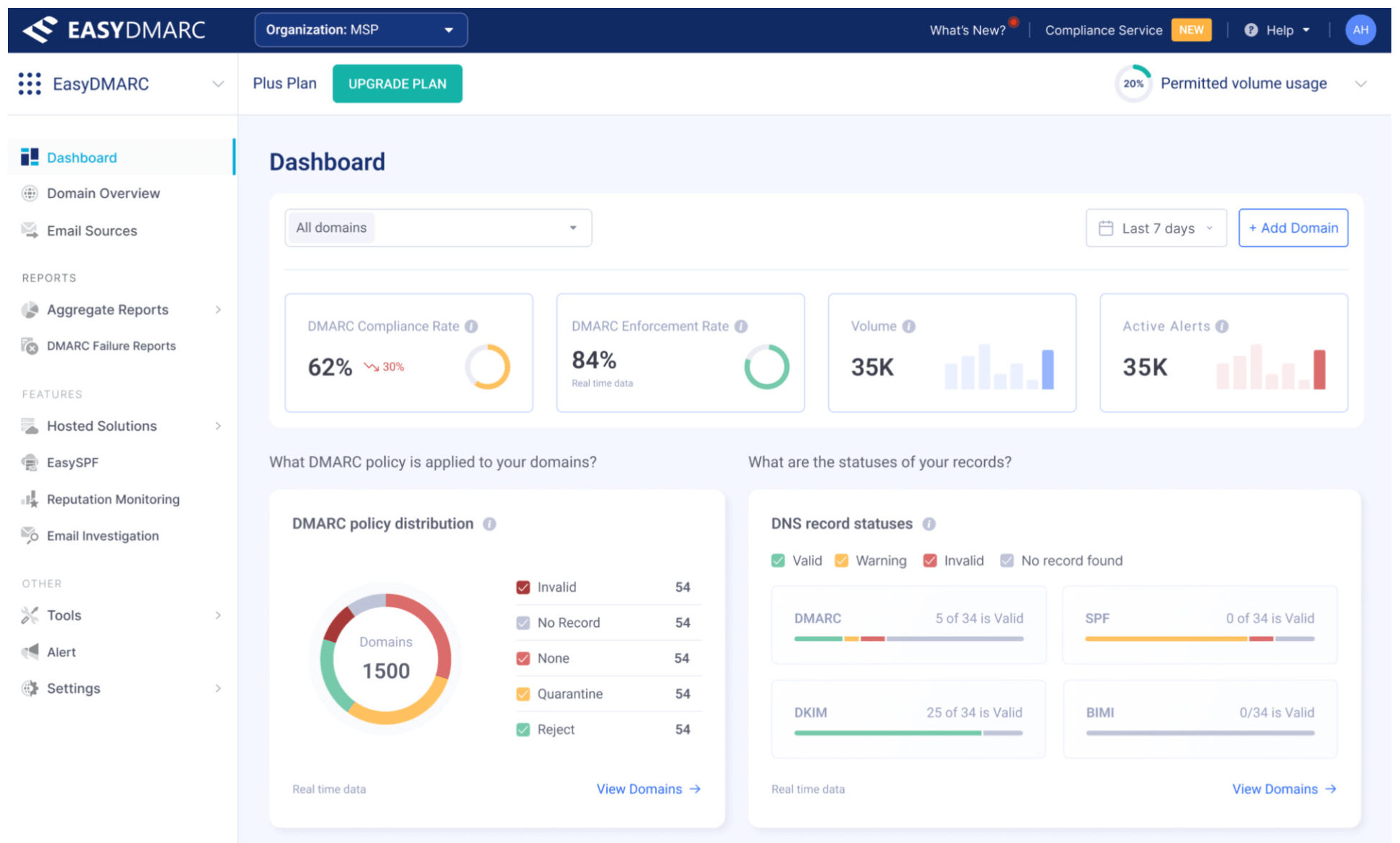
EasyDMARC is a comprehensive platform built for organizations that want full visibility and control over their email authentication. It goes beyond simple record lookups by providing dashboards, forensic reports, and tools to enforce DMARC policies across multiple domains.
There is also a handy integration with Cloudflare, allowing you to set up the DMARC record in a single click (if your domain’s DNS is managed in Cloudflare). Advanced features include BIMI record management, SPF flattening to simplify DNS records, and email source analysis that helps pinpoint unauthorized senders.
Pros
- Full suite of DMARC, SPF, DKIM, and BIMI management tools
- Clear dashboards that visualize DMARC alignment and sources of spoofing
- Includes SPF flattening, making large setups more manageable
Cons
- Support is available only on more expensive plans
- It may be overwhelming for smaller businesses without technical expertise
Pricing
EasyDMARC offers a free tier with basic functionality (1,000 monthly emails, 14-day data history, visualization of your XML file, etc.). It can be a great solution for small websites that do not require e-commerce features. Paid plans include more advanced features and tools and start at $44.99/month.
3. Dmarcian
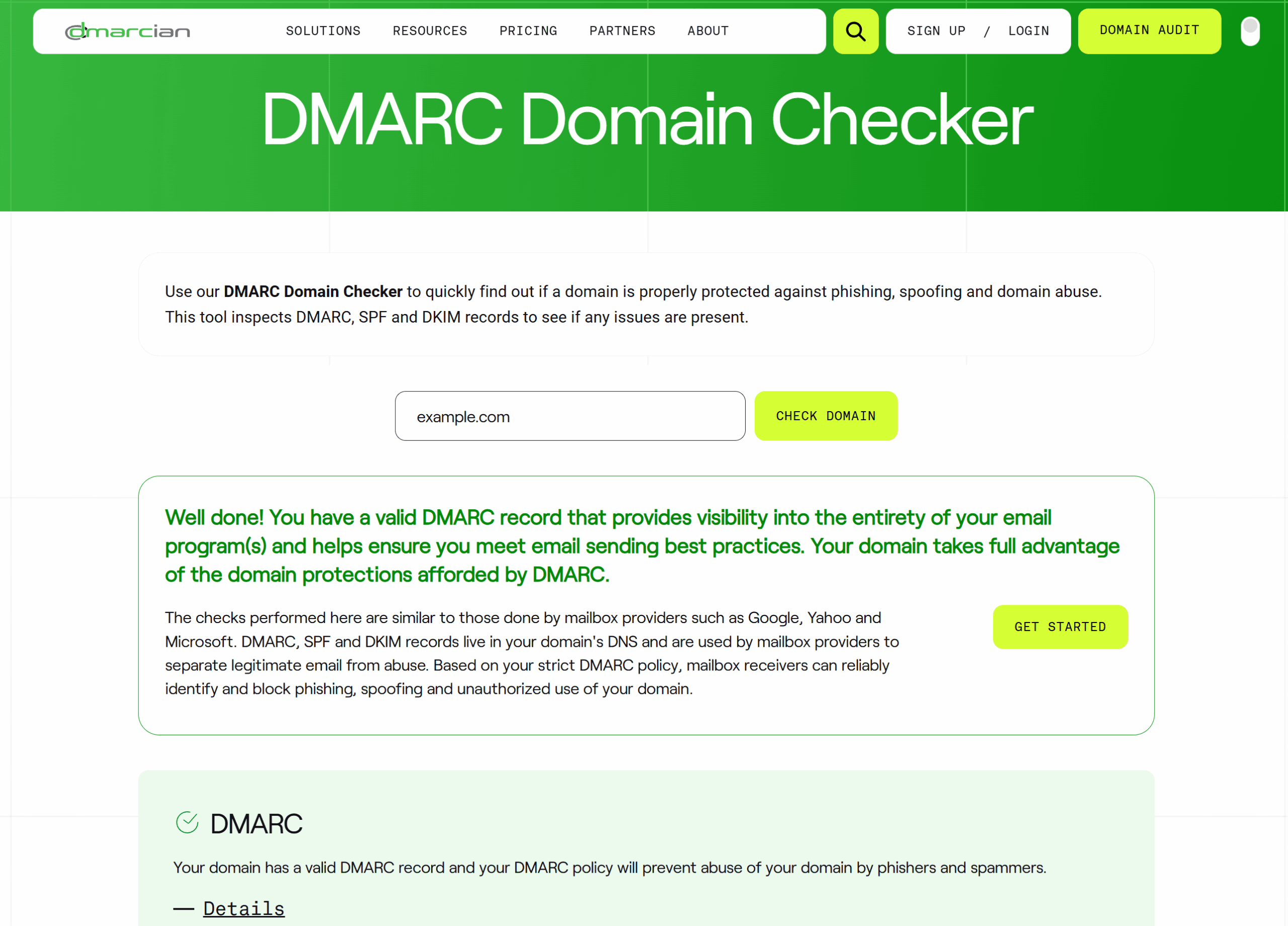
Dmarcian is among the most trusted solutions, created by a co-author of the DMARC standard. The tool focuses on helping businesses understand, deploy, and maintain DMARC with step-by-step guidance.
The platform collects aggregate and forensic reports, translates them into accessible visuals, and provides actionable recommendations for moving from “monitor” to “reject” policies safely. It has a strong knowledge base and a smooth setup process, making it ideal for both personal and commercial use.
Since Dmarcian is a comprehensive tool, it may feel “intimidating” or advanced for beginners.
Pros
- Clear visuals that simplify raw reports
- Trusted platform with strong documentation
- Scales well from small businesses to large enterprises
Cons
- Interface feels more functional than modern compared to newer competitors
- Some advanced features are available on higher-tier plans
Pricing
Dmarcian offers a lengthy 30-day free trial. Paid plans start at $24/month (billed monthly).
4. PowerDMARC
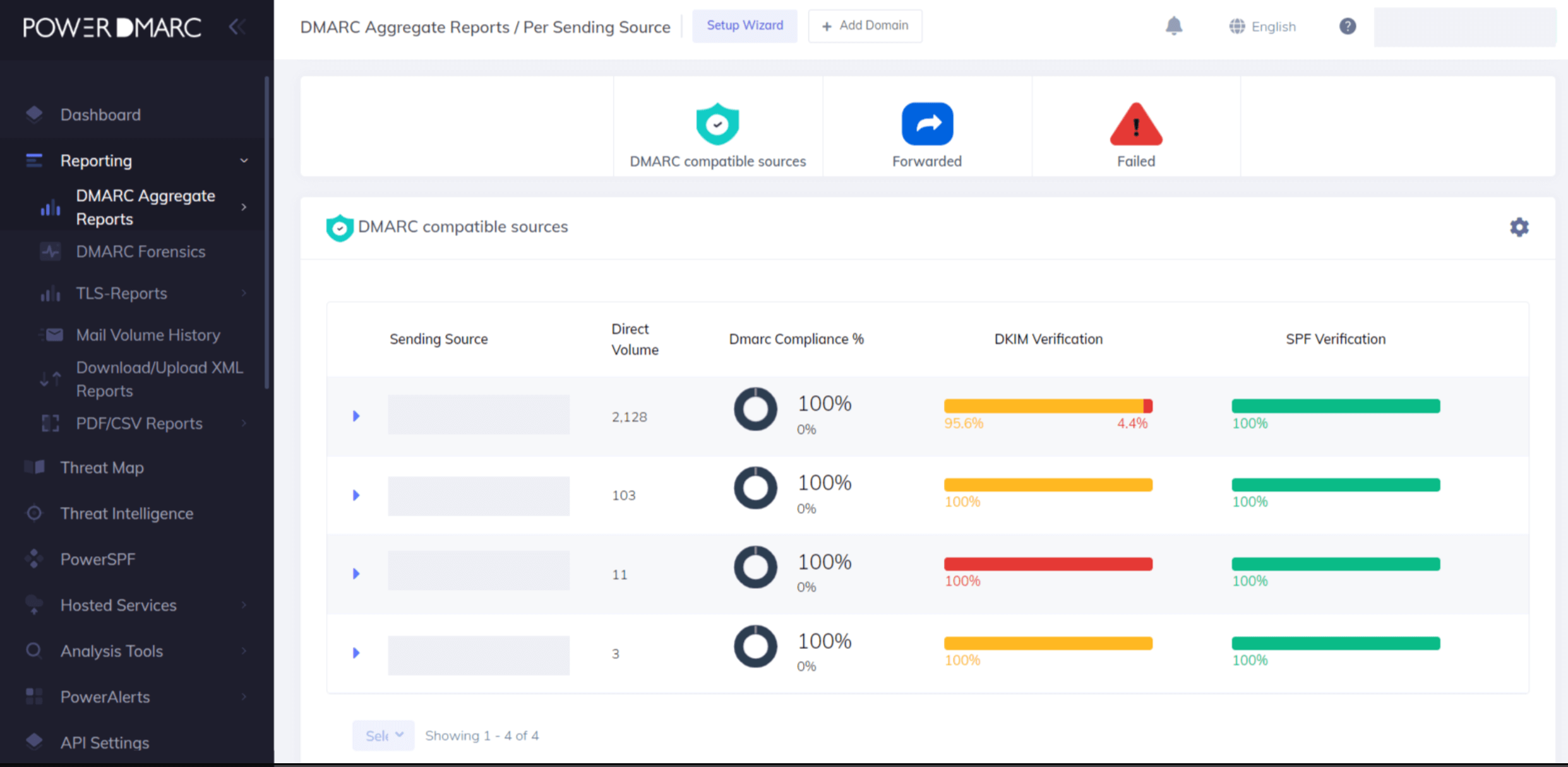
PowerDMARC is built for organizations that want deep visibility into how their domains are being used across the internet. It provides detailed reporting that breaks down every sending source, authentication status, and policy alignment in real time.
The platform supports not only DMARC but also related standards like SPF, DKIM, MTA-STS, and BIMI, making it a full-stack email authentication solution. It also comes with AI threat intelligence, which can detect phishing attempts and brand abuse early.
Pros
- Highly detailed DMARC aggregate and forensic reporting
- AI-powered threat detection for proactive protection
- White-label option for service providers and enterprise use
Cons
- Advanced features may be more than smaller businesses need
- The setup process could be smoother
Pricing
The tool offers a 15-day free trial. Paid plans start at $8/month.
5. OnDMARC
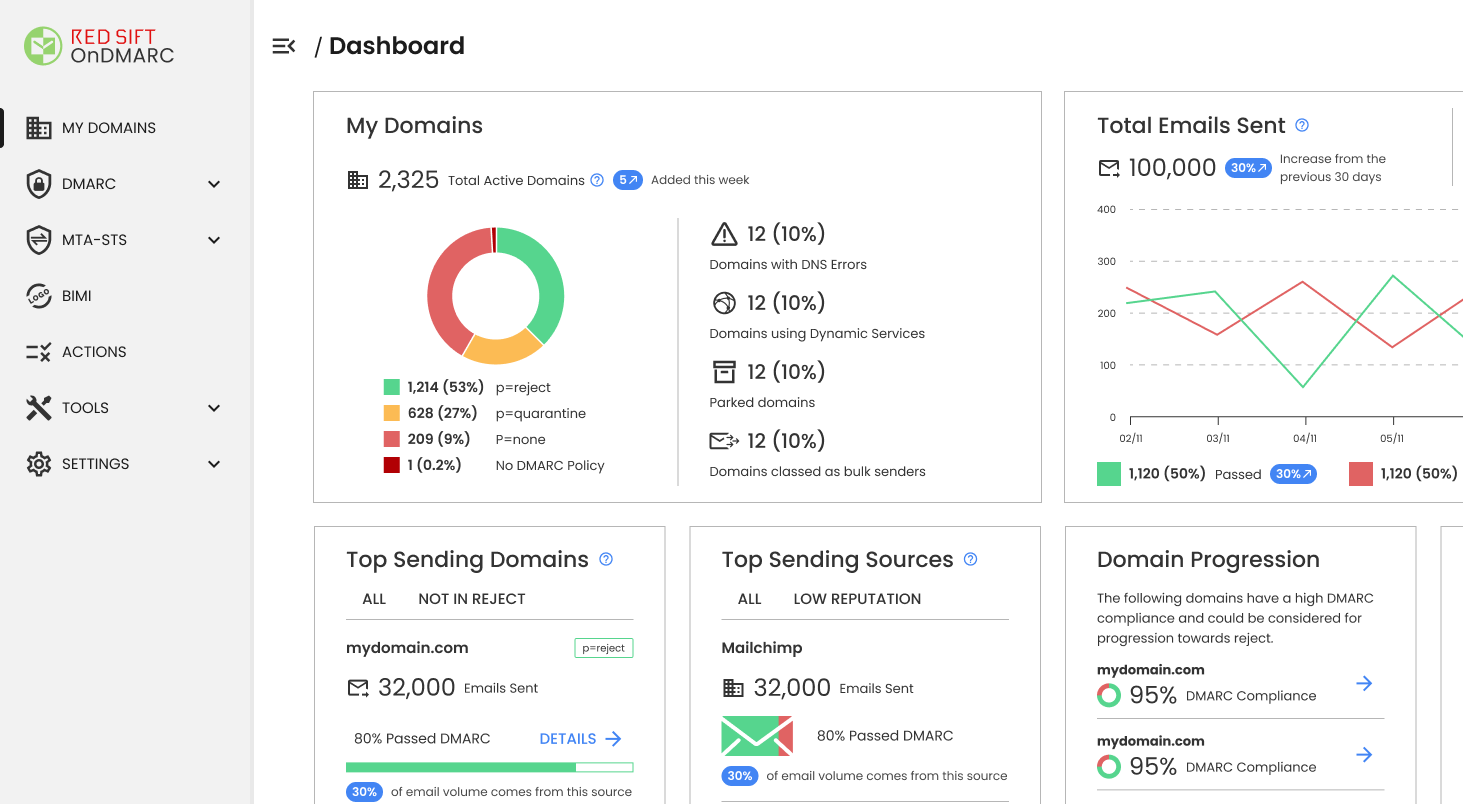
OnDMARC is designed to make DMARC adoption straightforward, even for businesses without in-depth technical expertise. One of its best features is the guided setup process that provides step-by-step recommendations on how to configure SPF, DKIM, and DMARC records correctly.
The platform automatically analyzes your email ecosystem, highlights misconfigurations, and suggests the safest next steps so you can move toward a strict enforcement policy with confidence.
OnDMARC also supports BIMI for displaying brand logos in inboxes, which acts as an additional layer of security for your business and reputation.
Pros
- Manage SPF, DKIM, DMARC, and MTA-STS records from a single interface
- Intuitive, beginner-friendly interface with guided configuration
- Useful for organizations with limited IT resources
Cons
- Less customizable than some advanced, enterprise-focused tools
- Pricing is higher than basic monitoring solutions
- No forensic reporting on the Basic plan
Pricing
OnDMARC offers a 14-day free trial. Paid plans start at $46/month, with pricing scaling based on the number of domains and features required.
6. Valimail
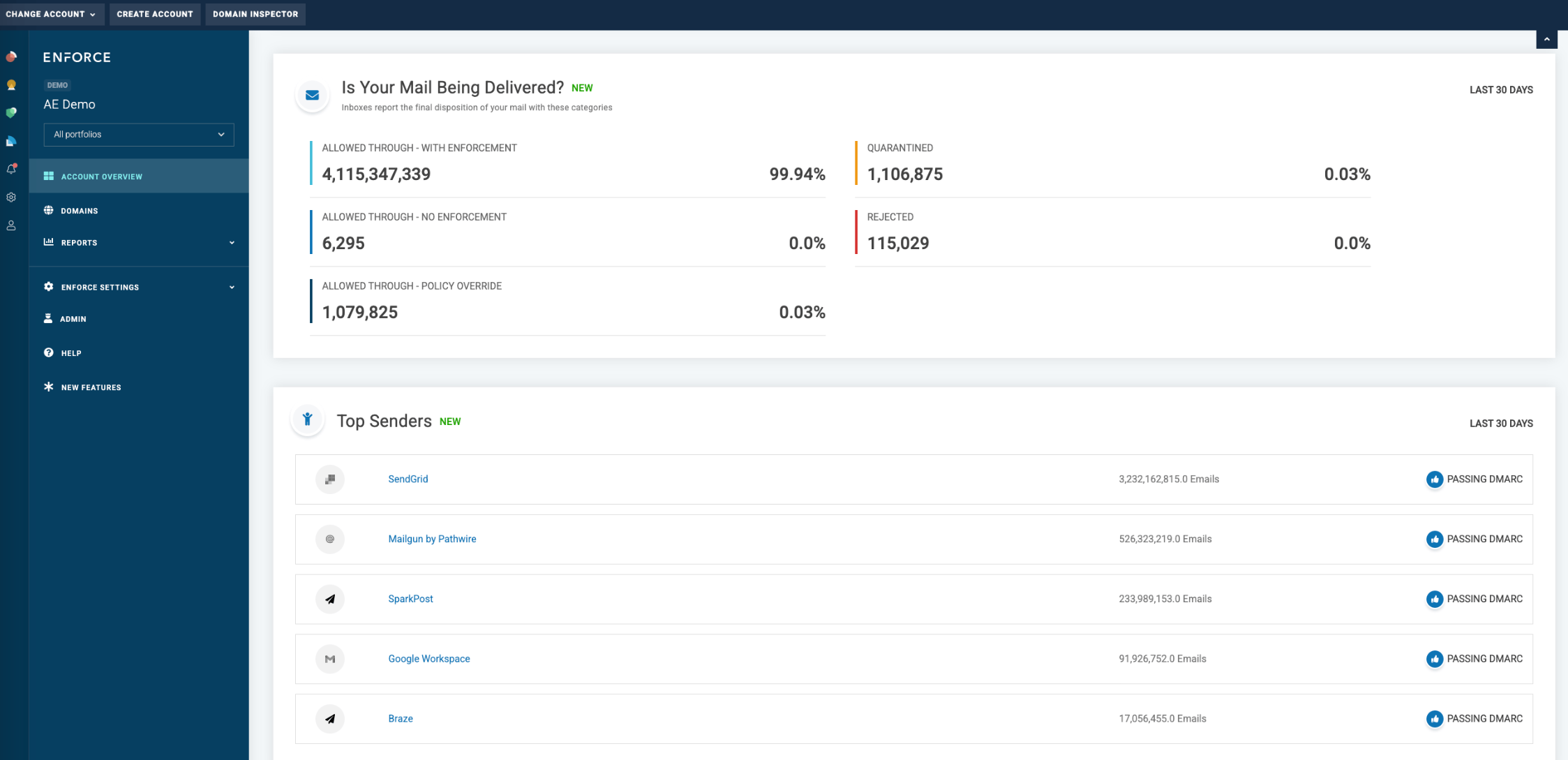
Valimail is another worthy tool to consider if you want to automate DMARC enforcement. Instead of manually tweaking DNS records or digging through XML reports, the platform guides you through setup with clear instructions and handles much of the process in the background.
Its automation feature can automatically discover all the services sending email on your behalf and help you authorize or block them with a few clicks.
The polished and intuitive dashboard also shows you which sources are compliant and where enforcement gaps exist. For larger organizations, integrations with Microsoft 365, Google Workspace, and other major providers make rollout much smoother.
While smaller teams may find it more than they need, Valimail is one of the most efficient solutions for enterprises that want scale and minimal manual work.
Pros
- Strong automation reduces manual DNS record management
- Detailed reporting and monitoring abilities
- Integrates with major providers for seamless deployment
Cons
- Geared toward larger businesses, it may be overkill for small teams
- Pricing is less transparent than that of other DMARC software
Pricing
Valimail offers a free tier called Valimail Align, which covers basic DMARC alignment monitoring. For advanced automation and enforcement features, pricing is customized to meet the specific needs of each enterprise.
Improving Your Security with DMARC Software
Securing your domain with DMARC is essential for protecting your brand, your customers, and your sender reputation. Whether you select a free tool or commit to a more robust solution, the important step is getting started.
With DMARC in place, you’ll face fewer phishing attempts, build more trust in your emails, and strengthen the foundation of your digital communication.
Frequently Asked Questions (FAQs)
Here are some common questions around DMARC platforms.
1. What is DMARC?
DMARC is an email security standard that helps organizations protect their domains from being misused in phishing and spoofing attacks. It makes sure that only authorized senders can use your domain to send emails, while also giving you reports to see who is trying to send on your behalf.
2. What is SPF and DKIM?
SPF (Sender Policy Framework) and DKIM (DomainKeys Identified Mail) are two methods used to verify that an email really comes from the domain it claims. SPF checks whether the sending mail server is allowed to send emails for your domain, while DKIM adds a digital signature to prove that the message hasn’t been altered in transit. Together, they help prevent spammers and phishers from forging your emails and are key building blocks for DMARC.
3. What are the benefits of using DMARC software?
DMARC tools make it easier to protect your domain from phishing, spoofing, and unauthorized use. Instead of working through complex raw reports, it gives you clear dashboards and alerts to spot threats quickly. It also helps you enforce authentication policies safely, improve email deliverability, and maintain a strong sender reputation. In short, DMARC software saves time, reduces risk, and builds trust in your emails.
4. Is DMARC difficult to implement?
Setting up DMARC can be tricky if you do it manually, since it involves editing DNS records and interpreting raw XML reports. However, DMARC software makes the process much easier. Most tools guide you step by step, provide clear recommendations, and translate reports into dashboards you can actually understand. This way, even teams without deep technical expertise can roll out DMARC safely and move toward full enforcement.
5. Are there any free DMARC tools available?
Yes, several free DMARC tools can help you get started. Moosend’s Free DMARC Checker lets you instantly verify if a domain has a valid DMARC record and whether it’s properly configured. Another free option is EasyDMARC, which provides limited reporting for a single domain. While these tools are great for quick checks, businesses that need ongoing monitoring usually benefit from upgrading to a paid solution.




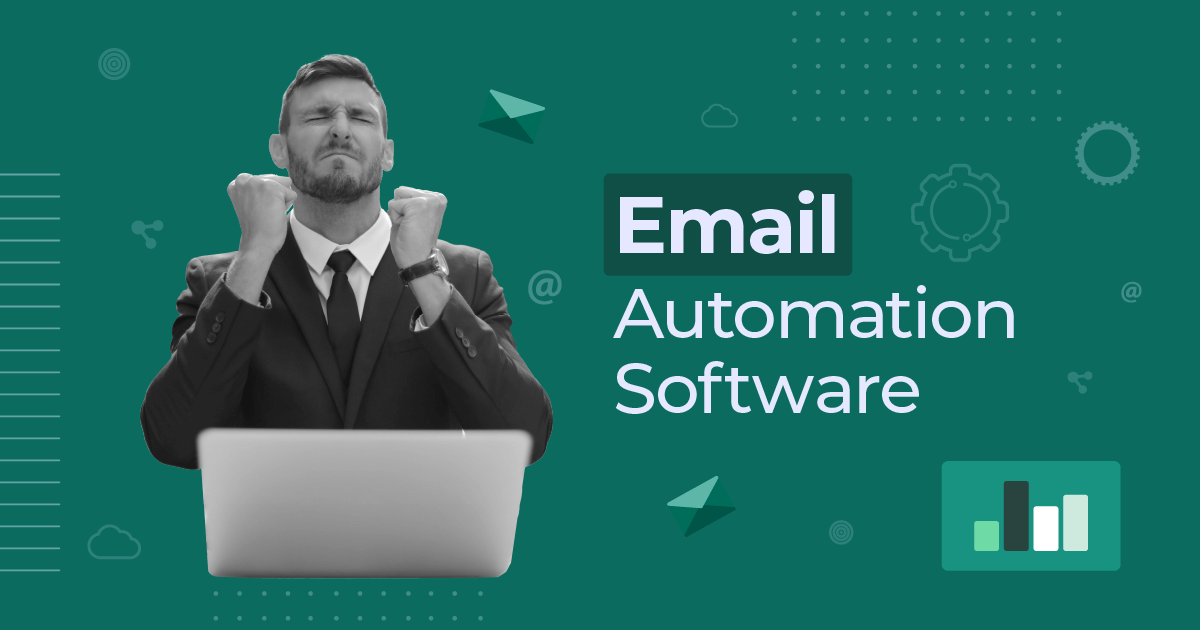

 Published by
Published by